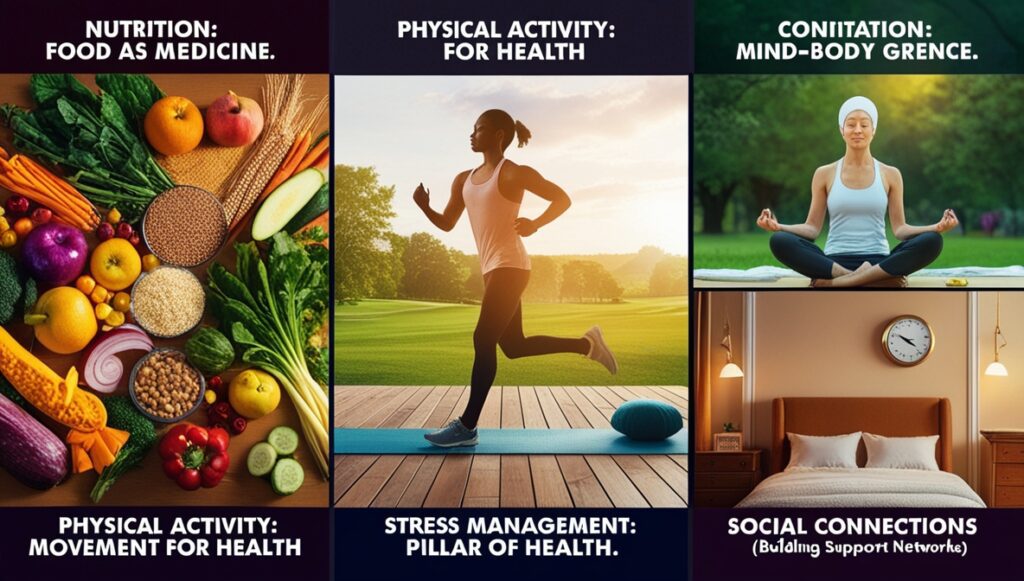Health is no longer an abstract term referred to as the absence of disease. In our high-speed society but a dynamic condition of being healthy and sound physically, mentally, and socially. Management of this medical lifestyle has been based on evidence-based. The medical practices are integrated with holistic lifestyle modifications to promote long-term wellness. Medical lifestyle has moved beyond treating the disease. It emphasizes preventive care, healthy living, and motivating the patient to take action toward an improved health condition. To explain this further, what would be the primary features of a medical lifestyle, and how could it be a starting point for the development of modern healthcare?

The Evolution of the Medical Lifestyle
Health care used to focus mainly on treating diseases once they occurred according to the “reactive care” pattern. However, with the development in the medical sciences, it has been observed that most chronic diseases are lifestyle-related and include heart disease, diabetes, and certain cancers. This understanding introduced a new paradigm toward this proactive and preventive approach to health care, essentially the crux of the medical way of life.
Medical lifestyle movements grew in the 21st century, mainly due to the rise of integrative and functional medicine, which is all about treating the person, not merely symptoms. So, one can encourage lifestyle modification to improve diet, increase physical activities, optimum stress management, and promote sleep hygiene, thereby bringing in disease risks and enhancing the general quality of life.

Core Components
A medical lifestyle is based on some highly science-backed principles. That ought to facilitate healthful activities for obtaining optimal health through:-
1. Nutrition: Food as Medicine
Nutrition is a crucial aspect of health and recovery. What we eat is the fuel for our bodies’ proper working, and unhealthy eating is linked with most chronic diseases. A healthy lifestyle typically involves consuming food that comes as naturally from its source as possible, foods rich in nutrients. The Mediterranean diet, any other plant-based diet, and the DASH diet generally find favour because there is supportable evidence about their health benefit.
A well-balanced diet of vegetables, fruits, whole grains, lean proteins, and healthy fats can reduce inflammation, support immune function, and lower one’s risk for other conditions such as obesity, cardiovascular disease, and type 2 diabetes. A personalized nutrition approach, recognizing that every individual is unique in their genetic makeup, medical history, and lifestyle, is typically encouraged by a medical lifestyle practitioner.
2. Physical Activity
Exercise forms the cornerstone of a medical lifestyle, with solid evidence that it reduces the incidence of chronic diseases, including heart disease, stroke, hypertension, and certain cancers. Mental health benefits are also accrued, symptomatically lowering depression and anxiety symptoms and increasing cognitive functioning.
The concept of medical lifestyles will include:-
- A minimum of 150 minutes per week of moderate-intensity aerobic activity.
- Seventy-five minutes per week of vigorous-intensity activity.
- Strength training exercises.
Though these exercises can be formalized into a fitness routine, a medical lifestyle encourages daily movements through walking, stretching, gardening, swimming, and many other activities. It suggests the creation of a lifelong pattern of exercise that is made a normal part of life.
3. Stress Management
The more chronic the stress, the higher the impact on poor health outcomes. Such as cardiovascular disease, digestive problems, and weakened immune function. In a medical lifestyle, stress management is treated equally, if not more important, than other health habits. Techniques such as mindfulness and meditation, deep breathing, and yoga can be woven into daily routines. It’s to help individuals cope better with the pressures of modern living.
Evidence-based interventions include mindfulness-based stress reduction (MBSR) and cognitive-behavioral therapy (CBT), as they have positive results on the level of stress and anxiety. The medical lifestyle approach sees the mind-body areas as closely related. So overall health and wellness improve when an individual develops mental resilience.
4. Sleep
Though sleep plays a critical role, it is rarely discussed as a crucial element in health. However, restful sleep is vital for individuals to rejuvenate their bodies and minds. Research studies have found sleep deprivation to be associated with many health conditions. That starts from obesity, diabetes, heart conditions, and finally, cognitive impairment.
A healthy lifestyle calls for sleep hygiene practices. Such as having regular sleep schedules, a conducive environment to sleep, and avoiding exposure to electronic screens before retiring. Treating sleep as an essential part of life will guarantee better mood, concentration, and general quality of life.
5. Social Connections and Community
Humans are social beings by nature, and their relationships are essential to their health. For a long time, research has shown that people who lead isolated and lonely lives have higher risks. They have cardiovascular diseases, depression, and even early mortality. By contrast, a medical lifestyle seeks to help one develop socially within one’s family, friends, or community.
Community-based activities, group exercises, and social support networks are as important in supporting mental and physical health. Doctors and medical professionals may even be able to “prescribe” social activities as part of a fuller medical lifestyle plan.

Medical Lifestyle and Disease Prevention
A beautiful feature of a medical lifestyle is preventing disease before it happens. This is an essential difference because most conventional medicine focuses on managing symptoms or curing illness once the disease has been set in motion. This means chronic diseases can be reduced much earlier in life because lifestyle medicine is preventive.
For instance, a healthy lifester will never develop high blood pressure or insulin resistance, leading to heart disease and diabetes, because one exercises regularly, eats healthily, manages stress, and sleeps enough. Such preventive measures not only enhance individual health outcomes. But also lower the burden on the healthcare system through reduced costs of expensive treatments and interventions.

The Role of Medical Professionals
They educate patients to lead healthy lifestyles. Physicians, dietitians, physical therapists, and other behavioral health professionals pool their efforts to establish unique care plans while tailoring the needs for care to certain patient requirements. Instead of penning prescriptions, medical practitioners become coaches and educators to empower patients’ decisions for their health.
The introduction of lifestyle medicine in clinical practice requires a change in mindset. It involves educating patients on the impact of their day-to-day choices on long-term outcomes. Because of its increasing significance in modern healthcare, lifestyle medicine has increasingly found its place in the curriculum of many medical schools and continuing education programs.

Challenges and Barriers to Adopting a Medical Lifestyle
There are, however numerous challenges of this medical lifestyle. Probably the most significant is the pervasive nature of unhealthy societal norms. Fast food, sedentary lifestyles, and high-stress environments are so engrained in modern culture that people have a hard time changing permanently.
Economic factors are also involved. In poor areas, for instance, there can be a dearth of a healthy food basket, while membership in a gym or wellness program will prove out of bounds to some for economic reasons. However, such inequalities need systemic adjustments to lift such matters off the ground, with just policies galvanizing the providing of healthy food baskets, provision for space with no violence that guarantees physical activities and mental health.
Change is hard by its very nature. Not even that the strongest intentions can’t sustain new behaviors long enough. For this reason, practitioners of a medical lifestyle recommend gradual, lasting changes rather than magic solutions that make you fly.

The Future of Medical Lifestyle
Healthcare is rapidly adopting a model of care with lifestyle medicine as an integral part of the care process. What was initially discovered is now, through research, unfolding the profound influence lifestyle has on health. Medical professionals and lawmakers increasingly recognize the need to focus on prevention and wellness.
Technology is now playing an increasingly supportive role in medical lifestyle interventions. Devices such as wearable fitness trackers, tele-health platforms, and applications allowing users to track diet and stress enable people to take on health management in ways not possible a decade ago. It is this digital revolution that opens the principles of a medical lifestyle to a vastly larger segment of the population.

Conclusion
The medical lifestyle is a transformational approach to healthcare. It means moving from individualist health care towards finding a cure after diagnosis and toward a more holistic approach of prevention, wellness, and responsibility of the person who controls their body. An integrated approach to nutrition, physical activity, stress management, sleep, and social connection placed upon their lives, as well as a medical lifestyle, gives the main objectives to achieve perfect health and prevent disease. A medical lifestyle, conceived and living out in an evolving healthcare landscape, will most likely be considered an essential part of how we approach the health and well-being of people in the 21st century.
This direction from reactive care to proactive care is not just good individually. Still, it will also diminish the overall burden on the healthcare system, making it a win-win solution for both patients and providers.
like


